#Cretaceous bivalve
Explore tagged Tumblr posts
Photo

Polished Fossil Bivalve | Lower Cretaceous Madagascar | Genuine Specimen with COA
Add a polished piece of prehistoric marine life to your collection with this exquisite Fossil Bivalve from the Lower Cretaceous period, discovered in Madagascar. Carefully polished to enhance its natural beauty, this specimen is a unique example of ancient marine molluscs and a stunning addition to any fossil or natural history collection.
Fossil Type: Bivalve Mollusc
Geological Period: Lower Cretaceous (~145 to 100 million years ago)
Location: Madagascar
Scale Rule: Squares/Cube = 1cm (Please see photo for full sizing details)
Specimen: The photo shows the exact item you will receive
Authenticity: All of our fossils are 100% genuine specimens and come with a Certificate of Authenticity
Geological and Paleontological Information
This fossil bivalve originates from marine deposits formed during the Lower Cretaceous, a time when Madagascar was part of the southern supercontinent Gondwana. These ancient seas supported a diverse array of molluscs, including bivalves like this example. While the exact genus and species are not specified, bivalves from this region and period are often linked to families such as Trigoniidae, Inoceramidae, or Ostreidae, common in Cretaceous marine strata.
Phylum: Mollusca
Class: Bivalvia
Morphological Features: Typically two symmetrical shells joined by a hinge; this specimen is polished to reveal structural details such as growth lines, shell ridges, and colour banding within the mineralised shell
Depositional Environment: Shallow marine environment with fine-grained sediment, conducive to fossilisation of shell-bearing organisms
Geological Stage: Likely from the Barremian to Aptian stages of the Early Cretaceous (specific stratigraphy not provided)
Notable Aspects
Polished fossil bivalves from Madagascar are prized for their excellent preservation and the stunning patterns that emerge when polished. These fossils represent not only a window into marine life over 100 million years ago but also the geological history of Madagascar's evolving sedimentary basins.
Why Buy From Us?
100% genuine fossil guaranteed with Certificate of Authenticity
Polished for display, study, or gifting
Carefully sourced and curated specimen
Actual item shown in photographs
Own a beautifully preserved piece of natural history today with this authentic polished fossil bivalve from the Lower Cretaceous of Madagascar — a true relic of Earth’s ancient oceans.
#fossil bivalve#polished fossil bivalve#Madagascar fossil#Lower Cretaceous fossil#Cretaceous bivalve#genuine fossil#certified fossil#fossil with COA#fossil shell#fossil mollusc#natural history fossil#collector fossil#Cretaceous period fossil#Madagascar geology#authentic fossil#fossil gift#marine fossil#bivalvia fossil
0 notes
Text
Round 3 - Actinopterygii - Cypriniformes




(Sources - 1, 2, 3, 4)
Order: Cypriniformes
Common Name: no common name for the whole order
Families: 23 - Gyrinocheilidae (“algae eaters”), Catostomidae (“suckers”), Botiidae (“pointface loaches”), Vaillantellidae (“long-fin loaches”), Cobitidae (“true loaches”), Barbuccidae (“scooter loaches”), Gastromyzontidae (“hillstream loaches”), Serpenticobitidae (“serpent loaches”), Balitoridae (also “hillstream loaches”), Ellopostomatidae (“square-head loaches”), Nemacheilidae (“stone loaches”), Paedocyprididae (“tiny carps”), Psilorhynchidae (“mountain carps”), Cyprinidae (“carps”, “minnows”, “barbs”, and “barbels”), Sundadanionidae (“tiny danios”), Danionidae (“troutbarbs”, “rasborines”, “danionines”, and “flying barbs”), Leptobarbidae (“cigar barbs”), Xenocyprididae (“East Asian minnows” or “sharpbellies”), Tincidae (“Tench”), Acheilognathidae (“bitterlings”), Gobionidae (“freshwater gudgeons”), Tanichthyidae (“mountain minnows”), and Leuciscidae (“true minnows”)
Anatomy: thick body; one dorsal fin; lack teeth in the mouth, but have convergent structures called pharyngeal teeth in the throat, which grind against a chewing pad on the base of the skull; most are equipped with barbels to help them locate food at night or in murky conditions
Diet: algae, plankton, plants, insects, snails, worms, small fish
Habitat/Range: Worldwide; most species are strictly freshwater, but some are found in brackish water, and at least one species is found in saltwater, though brackish and marine species swim upstream into rivers to spawn
Evolved in: Late Cretaceous

Propaganda under the cut:
The Bigmouth Buffalo (Ictiobus cyprinellus) can reach an age of up to 127 years, making it the oldest known freshwater teleost fish.
The Indonesian Superdwarf Fish (Paedocypris progenetica) is one of smallest known species of fish in the world. The smallest mature female measured 7.9 mm (0.31 in) and the largest known individual was 10.3 mm (0.41 in).
The critically endangered Giant Barb (Catlocarpio siamensis) (image 1) is the largest species of Cyprinid, with an unconfirmed maximum length of 3 m (9.8 ft) and weight up to 300 kg (660 lb).
The Pacific Redfin (Pseudaspius brandtii) is the only Cypriniform known to inhabit salt water, and is found from the Siberian Pacific Coast through coastal Japan.
At least three loach families contain blind, troglomorphic species adapted to life in caves.
The Tench (Tinca tinca) has very small scales, which are deeply embedded in a thick skin, making it as slippery as an eel. Folklore has it that this slime cured any sick fish that rubbed against it, and from this belief arose the another common name: Doctor Fish.
The Common Carp (Cyprinus carpio) is declining and even rated vulnerable in some of its native habitat, though introduced populations have become invasive in other environments worldwide, and it is considered one of the world’s most destructive invasive species.
The bitterlings of subfamily Acheilognathinae are notable for depositing their eggs in bivalve molluscs, where the young develop until able to fend for themselves.
The herbivorous Grass Carp (Ctenopharyngodon idella) is both cultivated for food and for aquatic weed control, and has been introduced into many areas to control undesirable aquatic vegetation. In China it is known as one of the "Four Great Domestic Fish".
The Thicktail Chub (Gila crassicauda), a type of minnow, was once the most common freshwater fish found in California. The chub was a favored food of the indigenous peoples of Clear Lake and the Central Valley, before it became heavily exploited by colonist commercial fishermen supplying the San Francisco market. Most of its habitat was also destroyed by the drainage of sloughs and marshes, dam-building, and water diversion for irrigation. The last known Thicktail Chub was caught on April 16, 1957. Just 70 years after being considered the most common freshwater fish in California, not a single living individual existed.
The critically endangered Red-tailed Black Shark (Epalzeorhynchos bicolo) (image 4) is popular in the home aquarium trade, but may in fact be extinct in its native habitat of Thailand.
Almost all domesticated fish belong to the Cypriniformes, and include the Koi (Cyprinus rubrofuscus var. koi or nishikigoi) (see gif above), Goldfish (Carassius auratus), and Zebrafish (Danio rerio), which have all been bred to display a variety of colors, patterns, fin types, and even body shapes.
The Zebrafish is one of the most important vertebrate model organisms in biological and biochemical studies, being used in many kinds of experiments. During early development, the zebrafish has a nearly transparent body, so it is ideal for studying developmental biology. It is also used for the elucidation of biochemical signaling pathways.
I have 6 Black Ruby Barbs (Pethia nigrofasciata) whomst I love with all my heart, and they turn deep purple and get the zoomies when they’re excited (usually when I feed them in the morning, when I come home from work, and after I clean the tank).

(source)
239 notes
·
View notes
Text
one thing i miss about being in a lab setting are the visiting scientists. i LOVED the lectures about cretaceous bivalves
#i most miss the validation i got when they quizzed me on what was what#talk#i’m out of practice now 😔
146 notes
·
View notes
Text
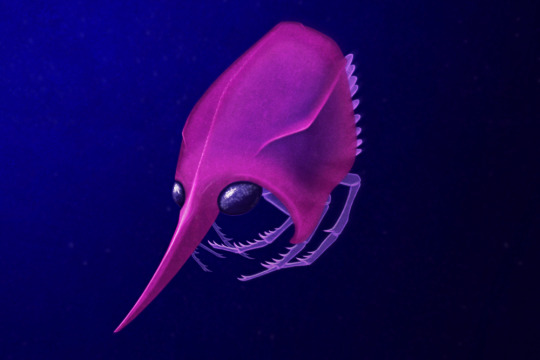
The enigmatic thylacocephalans were a group of bizarre little arthropods, found in marine deposits all over the world from the late Ordovician (~435 million years ago) to the late Cretaceous (~85 million years ago). They had shield-like bivalved carapaces, large compound eyes, three pairs of spiny grasping limbs, and multiple pairs of small paddle-like swimming limbs, but details of their internal anatomy are poorly known and their evolutionary relationships to other arthropods are still very uncertain.
Traditionally they've been classified as crustaceans, possibly as close relatives of remipedes or malacostracans – but they've also recently been proposed as instead being part of a much more ancient branch of arthropods, potentially related to stem-mandibulates like Acheronauta.
Falcatacaris bastelbergeri was a thylacocephalan living during the late Jurassic, about 150 million years ago, in what is now Germany. Around 2.5cm long (~1"), its carapace had tiny interlocking square "teeth" resembling a zipper along the hinge line between the two valves, a ridge along each side, and a long pointed knife-shaped spine at the front.
Like other thylacocephalans it was probably a swimming predator, likely nocturnal or hunting in murky conditions based on its enlarged eyes, and would have captured smaller aquatic prey using its raptorial limbs.
———
NixIllustration.com | Tumblr | Patreon
References:
Braig, Florian, et al. "A new thylacocephalan crustacean from the Upper Jurassic lithographic limestones of southern Germany and the diversity of Thylacocephala." Palaeodiversity 12.1 (2019): 69-87. https://doi.org/10.18476/pale.v12.a6
Laville, Thomas, et al. "Morphology and anatomy of the Late Jurassic Mayrocaris bucculata (Eucrustacea?, Thylacocephala) with comments on the tagmosis of Thylacocephala." Journal of Systematic Palaeontology 19.4 (2021): 289-320. https://doi.org/10.1080/14772019.2021.1910584
Pulsipher, Mikaela A., et al. "Description of Acheronauta gen. nov., a possible mandibulate from the Silurian Waukesha Lagerstätte, Wisconsin, USA." Journal of Systematic Palaeontology 20.1 (2022): 1-24. https://doi.org/10.1080/14772019.2022.2109216
Wikipedia contributors. “Thylacocephala” Wikipedia, 07 Nov. 2024, https://en.wikipedia.org/wiki/Thylacocephala
#science illustration#paleontology#paleoart#palaeoblr#falcatacaris#thylacocephala#crustacean#maybe#mandibulata#arthropod#invertebrate#art#actual ancient aliens#that is an excellent snoot
358 notes
·
View notes
Text

File:Opalized fossil bivalve (Bulldog Shale, Lower Cretaceous; Coober Pedy Opal Field, South Australia) 08 (15024739227).jpg
39 notes
·
View notes
Photo

🦖 Description des mollusques fossiles qui se trouvent dans les grès verts des environs de Genève /. Genève: impr. de Jules-Guillaume Fick, 1847-1853.. Original source Image description: Historical illustration depicting various fossilized mollusk shells from the Cretaceous period near Geneva. The image features detailed, black-and-white lithographic drawings of multiple bivalve species, including Astarte gurgitis, Crassatella Saxoneti, C. Sabaudiana, C. Fisiana, Cardita Constantii, and C. rotundata. Each shell is shown from different angles, highlighting distinct shapes, ridges, grooves, and hinge structures. The shells vary in form from rounded to elongated, with textured surfaces illustrating fine striations and anatomical features relevant to paleontological classification. The plate is labeled "Pl. 33" and includes scale bars for size reference.
25 notes
·
View notes
Text

Patreon request for rome.and.stuff (Instagram), and my first plesiosaur (well, first since I was like… 10)
Pliosaurus funkei!
Pliosaurs were a family of plesiosaurs that eventually lost their stereotypical long-necked, small-headed body plan. Resembling the mosasaurs that would come much later, pliosaurs had short necks with large, strong jaws, and fed on fish, cephalopods, and marine reptiles. The type genus, Pliosaurus, contains at least 6 species. The first and type species, P. brachydeirus, was described and named by Sir Richard Owen in 1841.
Between 2004 and 2012, a new species of Pliosaurus was in the process of being uncovered. Before it was formally described or even named, news of this giant sea monster escaped into the general media and it was dubbed “Predator X”.
This Predator X prompted a media frenzy… there were articles estimating its size based on the fragments found so far, a 2009 television special on the History channel, and a segment in the 2011 BBC documentary series “Planet Dinosaur.”
Predator X was reportedly the “most fearsome animal ever to swim in the oceans!”
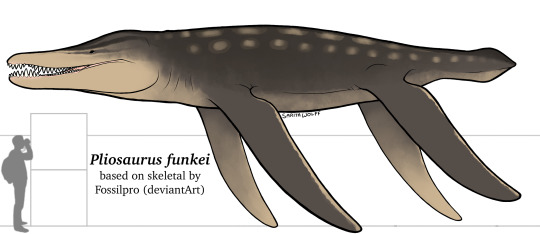
When Pliosaurus funkei was finally formally described and named in 2012, it was found to be a bit smaller than the giant 15 meter long estimate being thrown around. However, it was still a very large animal, around 10–12 m (33–39 ft) long with a 2.0–2.5 m (6.6–8.2 ft) long skull. It also had very long flippers, probably to aid in maneuverability and speed. Analysis of Pliosaurus funkei’s skeleton show that it likely used its front flippers to cruise, only using its back flippers for quick bursts of speed when pursuing prey. Analysis of its brain case shows that its brain was proportional to that of a modern great white shark. So while it didn’t quite beat the Late Cretaceous 12–15.8 meter (39–52 ft) long mosasaur Tylosaurus, the Early Miocene to Late Pliocene 10.5-20.3 meter (34-67 ft) long shark Otodus megalodon, or even the modern day 11-16 meter (36-52 ft) long Physeter macrocephalus (Sperm Whale), it was still no doubt the apex predator of its time and environment.
Pliosaurus funkei lived in the last era of the Late Jurassic in the icy waters of Norway. Found in the Slottsmøya Member of the Agardhfjellet Formation, it would have lived in a cold, shallow sea rife with methane seeps. These methane seeps supported a high amount of diversity, and the Slottsmøya was teeming with ammonites, bivalves, gastropods, brachiopods, tubeworms, echinoderms, cold water sponges, and more. Many icthyosaurs and plesiosaurs would have enjoyed feeding on the plentiful invertebrates here, as well as each other. Pliosaurus funkei would have likely fed on other plesiosaurs like Colymbosaurus, Djupedalia, Ophthalmothule, and Spitrasaurus, as well as icthyosaurs like Cryopterygius, Undorosaurus, Arthropterygius, Nannopterygius, and Brachypterygius.
#my art#SaritaDrawsPalaeo#Pliosaurus funkei#Pliosaurus#pliosaur#predator x#plesiosaurs#sauropterygians#reptiles
86 notes
·
View notes
Text

Bahamas 5 cent Sunrise Tellin Clam Shell postage stamp (1996)
This postage stamp was issued by the Bahamas on 2 January 1996 (Scott Catalogue # 849). It is part of a set depicting seashells. The 5 cent value shows a sunrise tellin clam shell, Tellina radiata (Family Tellinidae). Tellinid bivalves first appeared in the Cretaceous - they are infaunal filter-feeders that inhabit estuarine and marine settings.
Classification: Animalia, Mollusca, Bivalvia, Heterodonta, Cardiida, Tellinidae
Info at: en.wikipedia.org/wiki/Tellina_radiata
13 notes
·
View notes
Text
#2800 - Verpa penis - Watering Pot Shell

As usual I've saved something special for the milestone. Quite likely the weirdest bivalves in the world, and that's a group that includes shipworms and freshwater species that hitch a lift upstream in fish gills.
Originally described as Serpula penis by Linnaeus in 1758. But since Serpula is now a genus of tube worms, it certainly didn't stay there. Exactly whose penis is another question, but I'm sure you could find something similar in the Bad Dragon catalogue.
Another names have included Aquaria radiata, 10 different Aspergillum, three different Brechites, Clepsydra javanica, three Penicillus, and Serpula aquaria. An Aspergillum is a device for sprinkling holy water. One of the definitions of Clepsydra ('water thief') is a hollow brass ball with a long neck and lots of small holes around the bell, that if dipped in water will hold it until you take your thumb off the opening at the end of the neck. The common names also include waterspout shell. So all-in-all it would seem most of the taxonomists were making the same associations, based on the wide end of the shell being covered in dozens of tiny holes.
Most of those generic names are invalid because they'd already been applied to something else. I'm honestly amazed 'Verpa' hadn't already been applied to another animal, and it IS the name of a fungus genus. It means 'erect penis' in vulgar Latin, incidentally. Guess what the fungus looks like.
And they really are bivalves, although there's little evidence of that left in the adult shell.
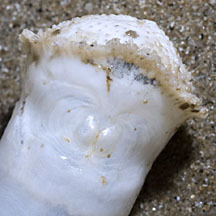
The Clavagelloidea includes genera that bore into living coral, but Verpa lives in soft sediments, with the wide end buried, and the long tube sticking up into the water. The bivalve's siphons run up the tube, to inhale and exhale water, but they can also use their mantle to pump water out through the small holes at the wide end. This presumably loosens the sand and mud, and helps secure the wide end as an suction anchor. Some have been found with sharp curves and bends in the tube, which probably indicates they got knocked over at some point but survived to keep growing.
Some research suggests that the genera in the Clavagelloidea that currently form the Penicillidae and the Clavagellidae actually evolved seperately, possibly from the Lyonsiidae, but converged on the same bizarre anatomy. Clavagellids first appeared in the Upper Cretaceous, but the Penicillids like Verpa didn't show until the Oligocene at least 40 million years later.
Found off the coast of SE Asia and Australia, but very rare and presumed extinct in some areas since they haven't been seen in 50 years.
Otago Museum, Dunedin, Aotearoa New Zealand
#Penicillidae#Clavagellidae#Clavagelloidea#Verpa#watering pot shell#weird molluscs#Otago Museum#Dunedin#Dunedin NZ
11 notes
·
View notes
Text
Patreon request for @/rome.and.stuff (Instagram handle) - Thanatosdrakon amaru
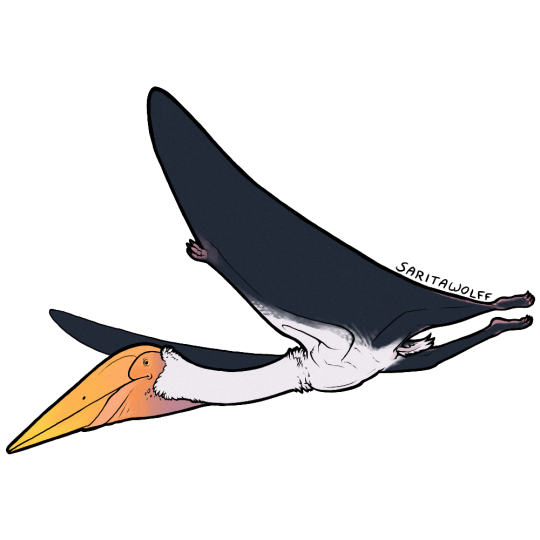
With a genus name meaning “dragon of death” and a species name meaning “flying serpent”, Thanatosdrakon amaru lays claim to quite possibly the coolest name of any pterosaur. An azhdarchid, it lived in Late Cretaceous Argentina. However, as the oldest known Quetzalcoatline, it came before the more famous North American Quetzalcoatlus. It was the largest pterosaur from South America, with an approximate wingspan of 9 metres (30 ft). Like other large azhdarchids, Thanatosdrakon was likely a stalking, land-based hunter of small animals, flying only to escape predators and move to new hunting grounds. It lived in a continental environment characterized by ephemeral rivers.
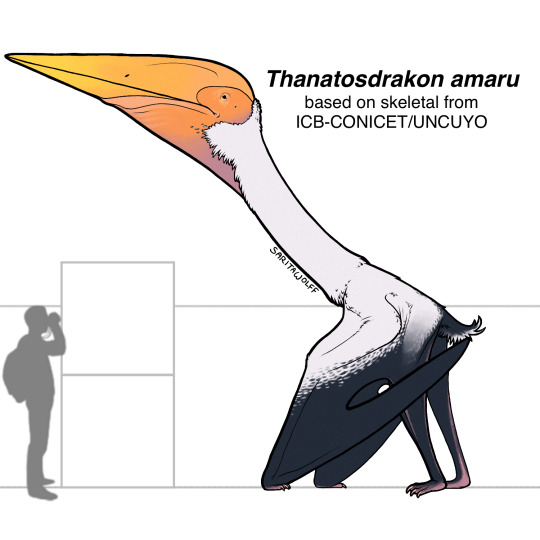
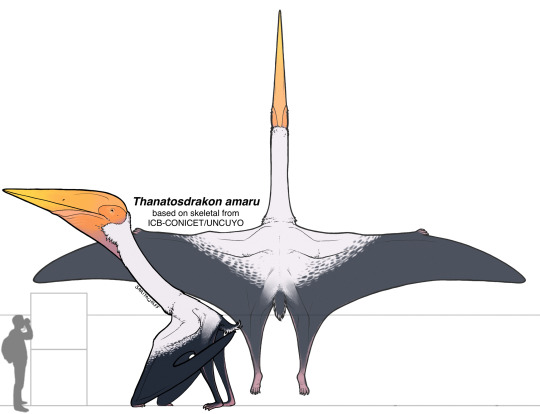
Living in the Upper Plottier Formation, Thanatosdrakon would have lived alongside the ornithopod Macrogryphosaurus and the titanosaurs Notocolossus, Petrobrasaurus, and “Antarctosaurus” giganteus. Predators included an indeterminate abelisaurid, basal coelurosaurian, an unenlagiine dromaeosaurid, and the notosuchian Lomasuchus. Mammals, fish, and freshwater bivalves were also common to this floodplain ecosystem.

This art may be used for educational purposes, with credit, but please contact me first for permission before using my art. I would like to know where and how it is being used. If you don’t have something to add that was not already addressed in this caption, please do not repost this art. Thank you!
#Thanatosdrakon amaru#Thanatosdrakon#azhdarchid#azhdarchids#pterosaurs#archosaurs#archosauromorphs#reptiles#SaritaDrawsPalaeo#Late Cretaceous#Argentina#Plottier Formation
15 notes
·
View notes
Text

Plartulox and Conecrete (Rock-Poison)
(Revived from the Cone Fossil)
Rogues of the deep sea, Plartulox and Conecrete are greedy and vain beasts,widely scorned throughout Ãrohwa and using their abilities for underhanded activities in turn, however it wasn't always this way...
Once they were revered throughout Ãrohwa for their beautifully patterned shells and assistance in reinforcing the islands with their cementlike slime, they grew discontented with their lack of praise compared to the tapu and the heroic pokemon who led them, and hatched a plan to capture and devour the tapu in the deep sea. Their plan however failed, and the subsequent witch hunt lead to a massive decline of the species, those remaining retreating to the deep sea trenches and abysses to the point many in Ãrohwa find it hard to believe they still exist.
However this current contempt belies another issue, as recently these pokemon have been targeted by seedy companies willing to exploit Plartulox and Conecrete for cheap "green" concrete, destroying the deep sea habitats they and many other rare pokemon live in to find them, after all, who would care about a creature so widely villanised...?
Welcome to fossil month! (Fossilcember?) A drawing challenge I have set myself to properly draw all of the different fossil mon I've created for the Ãrohwa region, starting with these two.
Design inspiration down below:
The four lines of fossil pokemon found across Ãrohwa are linked by a specific theme, theyre all based on Lazarus Taxa along with a specific extinct animal.
What's a lazarus taxa? An animal which when first described was thought to be extinct,and they're surprisingly common too . A famous example is the ceolocanth, initially described from mesozoic fossils in the 1800s and rediscovered in the 1930s (regardless that the east african fishermen who lived around that area knew it existed for an age before that but thought nothing of it as the fish was no good for eating,but I'm getting ahead of myself) but other examples include the chaco peccary, neptune cup sponge and Lord howe stick insect.



Regardless of all that, which creatures are Plartulox and Conecrete based on?
The primary inspiration for this pokemon are partula snails and cone snails. Both of these animals are found in the south pacific and are respectively threatened by invasive species (with many partula species going extinct) and overcollection respectively. Cone snails are also known for secreting a venom strong enough to be fatal to humans.


In terms of lazarus taxa, the closest I can find would be the bell clapper sea snail, an Australian species and last surviving member of its family (the shell pictured is of an eocene relative whose shell grew to over a meter long!)


There's also a mythological aspect to its lore, as it was inspired by the stories of Rogo-Tumu-Here, an octopus demon who captured the wife of one of the Tuamotan island's gods before being killed during her rescue.
Finally beyond that,there's scant inspiration from rudists (reef building cretaceous bivalves) cement mixers and evil sorcerers with tall wizard hats.
Anyway I hope you like these guys, see you next Wednesday for the next one!
7 notes
·
View notes
Text
Round 2 - Arthropoda - Thecostraca




(Sources - 1, 2, 3, 4)
Thecostraca is is a class of crustaceans, many of which have planktonic larvae which become sessile or parasitic as adults. The most well-known group are the Barnacles (subclass Cirripedia), but Thecostraca also includes the parasitic Ascothoracida, and the mysterious Facetotecta.
Facetotecta, comprising only the genus Hansenocaris, are known only from their larvae (image 3) and adults have yet to be recognized, though some scientists believe they may actually be larval tantulocaridans.
Ascothoracidans are parasites of echinoderms and cnidarians. Most genera are meso and endoparasitic (living inside the host) while some are ectoparasitic (living on the outside of the host). They are similar in anatomy to copepods, with six pairs of legs, an abdomen with four segments, a telson, and a bivalved carapace. They feed on their host via piercing and sucking mouthparts, and some more advanced species also absorb nutrients through the carapace. They are sexually dimorphic, in many cases so much so that the smaller males will live inside the larger female’s mantle cavity.
Barnacles (subclass Cirripedia) are more well-known than other Thecostracans. Adult barnacles are sessile filter feeders, except for the infraclass Rhizocephala, which are parasites of other crustaceans. Barnacles attach themselves to a surface as adults, be that a rock, the shell of a mollusc, a ship, or a large animal such as a whale. They come in two common forms: acorn barnacles which grow their shells directly on a surface (image 4) and goose barnacles which attach themselves via a stalk (image 1). Barnacles have a carapace made of six calcareous plates, with a lid made of four more plates. They attach themselves to the substrate by means of a cement gland at the base of their antennae. Eight pairs of thoracic limbs, called cirri, extend from the carapace to filter plankton from the water and bring it towards the mouth. The hairs on these limbs are very sensitive to touch, and help the barnacle sense the world around them. They also have three simple eyes (ocelli) which can sense changes in light, allowing them to close their plates quickly if a shadow is detected.
Thecostracans have nauplius larvae, characterised by a head with antennules, antennae, mandables, and a single eye, three pairs of limbs, a carapace, and a telson. Barnacle larvae are brooded by the parent until their first moult, after which they are released to swim freely using setae.
The oldest known thecostracan fossil is dated from the Middle Cambrian. Traces of the parasitic forms have been dated from the Cretaceous.

Propaganda under the cut:
Barnacles have the longest penis (relative to body size) of any living animal. You can see it in action in the above gif and in this video.
Most barnacles are not parasitic (other than hitching a ride) and usually do no harm to the large animals they attach to. An overload of barnacles tends to be a symptom of an underlying issue, such as the animal being unable to shed its skin. Non-professionals scraping or pulling barnacles off of whales and turtles often does more harm than good for the affected animal!
12th-18th Century Europeans thought that Brants and Barnacle Geese emerged, fully formed, from Goose Barnacles. Gerald of Wales claimed to have seen the birds hanging down from pieces of timber, William Turner accepted the theory, and John Gerard claimed to have seen the birds emerging from their shells. In County Kerry, until relatively recently, Catholics abstaining from meat during Lent could still eat this bird because it was considered a fish.
As filter-feeders, barnacles play an important role in the ecosystem: not only for transferring nutrients up the food chain, but also for keeping the water clean.
When a barnacle chooses its home, it produces a biological glue made of six different proteins. While the glue hardens, it accumulates limestone salts, turning into a concrete-like shell. Barnacle glue is six times stronger than any manmade glue. Scientists are trying to replicate this glue for use in the fields of engineering, construction and medicine, where it can be used as a biological sealant during or post-surgery.
#i could add SO MUCH more but I am trying to make these descriptions shorter both for your sake and for mine#looking forward to narrowing these down to smaller groups in later rounds where I won’t have to write So Dang Much#anyway crabs are coming in the next one#round 2#animal polls#arthropoda#thecostraca
37 notes
·
View notes
Text
one thing that always makes me want to cry is the fact people have been collecting fossils for THOUSANDS of years. they recently found a cave where neanderthals had collected bivalve and gastropod fossils… native people in the US made beads and jewelry out of crinoids.
so many older dwellings in the southwest were made with petrified wood!! in more recent history, archaeological excavations at civil war-era sites in the east found pinecone impressions (dating to the early cretaceous), collected by someone that was a slave.
such a rich history!! we all see these lil rocks and think they’re neat!!
#also makes me sad#we found these people’s treasures n now they just sit in collections somewhere instead of being cherished#talk
122 notes
·
View notes
Text
Links in lieu of propoganda Ilbandornis, a cenozoic dromornithid bird
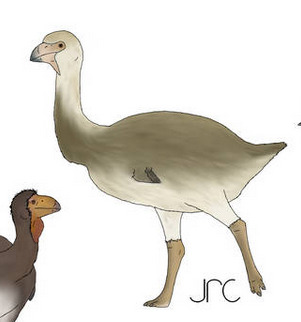
Inoceramus, a mesozoic giant bivalve

Isisfordia, a cretaceous crocodile

Isoxys, a cambrian bivalved arthropod

#please reblog#feel free to advocate for your favourite#palaeoblr#australian fossil alphabet thing#megafauna#ilbandornis#inoceramus#isisfordia#isoxys
29 notes
·
View notes
Text
I got to see some really well preserved dinosaur footprints over the weekend! Pics under the cut :3

The prints are from acrocanthosaurus and iguanodon! They date back to around 113 million years ago!!! We also have evidence that there were two iguanodons present, an adult and a juvenile.

Here’s a closer look at one of the iguanodon prints :)

I also got to do a fossil dig and I found a bunch of cool marine fossils! I was lucky enough to find a wonderfully preserved worm tube. I also found some bivalves, foraminifera, gastropods, and a sea urchin.
These are from the Cretaceous when America was split in two by the Western Interior Seaway, leaving Texas and some other states underwater. Texas being underwater is also why we have such great dinosaur footprints!
15 notes
·
View notes
Photo

Discohoplites subfalcatus Fossil Ammonite Upper Albian Cretaceous Morocco | Genuine Specimen with Certificate
Offered here is a well-preserved Discohoplites subfalcatus ammonite fossil, originating from the Upper Albian Stage of the Cretaceous Period, found in the rich fossil beds of Morocco, North Africa. This rare and attractive ammonite specimen dates to approximately 105–100 million years ago, when much of what is now northern Africa was submerged beneath a warm, shallow epicontinental sea.
The specimen shown in the listing is the exact fossil you will receive, carefully chosen for its scientific interest and display quality. All ammonites are supplied with a Certificate of Authenticity.
Geological & Palaeontological Details:
Species: Discohoplites subfalcatus
Fossil Type: Ammonite
Family: Hoplitidae
Superfamily: Hoplitoidea
Order: Ammonitida
Geological Period: Cretaceous
Stage: Upper Albian (approx. 105–100 million years ago)
Location: Morocco
Biozone: Often found within the Upper Albian ammonite assemblage zones of the Tafilalt region, although exact zone attribution may vary by locality
Depositional Environment: Shallow marine shelf rich in calcareous and siliceous sediments, supporting a high diversity of invertebrates such as ammonites, bivalves, and crustaceans. Conditions favoured the preservation of calcitic shells and internal moulds.
Morphology & Features:
Discohoplites subfalcatus is recognised by its flattened, discoidal shell, with strong falcoid (sickle-shaped) ribbing and an involute coiling pattern
Whorls exhibit pronounced ornamentation with ribs that bend forward toward the venter (outer edge)
May feature subtle tubercles and a slightly keeled venter, typical of advanced hoplitid ammonites
The combination of compressed form and delicate ribbing creates a visually striking fossil, both scientifically important and aesthetically appealing
Notability: Discohoplites subfalcatus is a classic Upper Albian ammonite genus originally described by Spath (1923). It is part of a key lineage used in the biostratigraphic correlation of Albian marine sequences across Europe and North Africa. Fossils from Moroccan beds are well-preserved and often studied for their evolutionary significance in Late Albian cephalopod assemblages.
Additional Details:
All our fossils are 100% genuine specimens
Supplied with a Certificate of Authenticity
The photo shows the exact fossil for sale
Scale cube = 1cm – refer to photos for full sizing
Whether for scientific study, display, or collecting, this rare ammonite from Morocco offers a captivating glimpse into the ancient marine ecosystems of the Late Albian seas. A standout piece for any fossil collection.
#Discohoplites#subfalcatus#fossil ammonite#Upper Albian#Cretaceous ammonite#Morocco fossil#North African ammonite#Discohoplites fossil#genuine ammonite#fossil with certificate#collector ammonite#display fossil#rare ammonite#Albian ammonite#ammonite from Morocco#marine fossil#fossil sea life#Hoplitidae#Cretaceous fossil
1 note
·
View note